Verstappen’s historic hat-trick — his French, Austrian and Styrian wins
For those who didn’t believe there was a true title fight on the cards for this year, Max Verstappen and Red Bull know there is, says Mark Hughes
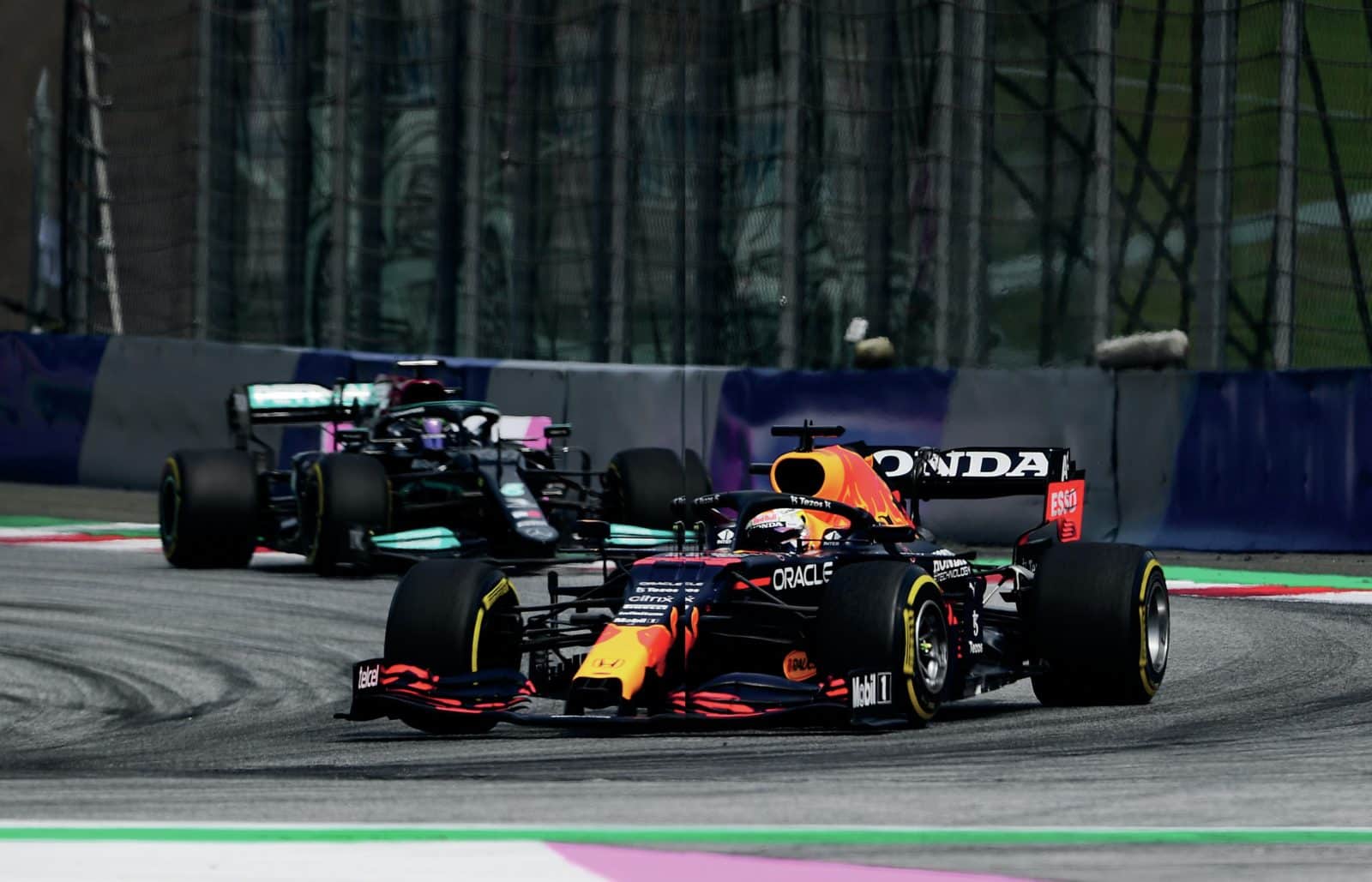
This triple header created an historic first: Max Verstappen became the first man in F1 championship history to win grands prix on three consecutive weekends. In doing so, he left Red Bull’s home track 32 points clear of Lewis Hamilton.
The Red Bull and Mercedes were quite evenly matched at Paul Ricard, but if Mercedes was expecting a repetition of Barcelona – the last ‘conventional’ track after the oddities of Monaco and Baku – where it had comfortably beaten Red Bull through better tyre usage, it was to be sorely disappointed. The two Austrian races which followed painted an exciting picture for Red Bull, Verstappen and Honda, one of complete domination.
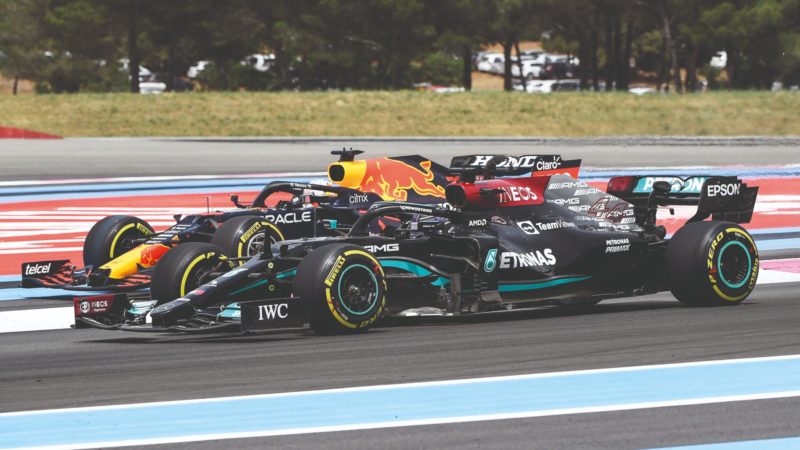
Red Bull is pushing development hard, whereas Mercedes has stalled
Getty Images
Red Bull continues to pile development on its car, Mercedes has essentially switched it off. These three races were where the impact of that started to become very apparent.
Barring a few development parts still in manufacture, the Mercedes W12’s spec is essentially frozen and the Brackley wind tunnel is now devoted entirely to the new regulations car of 2022. It’s only partly about prioritising the future over the present; everything Mercedes was seeing prior to the switch was saying there just wasn’t much in the way of development potential left in the car. It had plateaued. Under the 2021 regulations, the low-rake car just didn’t have anything left to give. The highrake Red Bull, by contrast, is proving extremely responsive to further development in the wind tunnel.
“Low-rake cars like the Mercedes have nothing left to give”
Let’s not forget Honda’s contribution, too. The tiny RA261 introduced ahead of time for Honda’s final year –a last chance, all-out strive for glory – has proved as powerful as the Mercedes and with slightly better deployment (i.e. it can keep delivering full power for slightly longer). For Ricard the Red Bulls (and AlphaTauris) were enjoying newly built-up units, the original examples having done six races already this season.
French Grand Prix
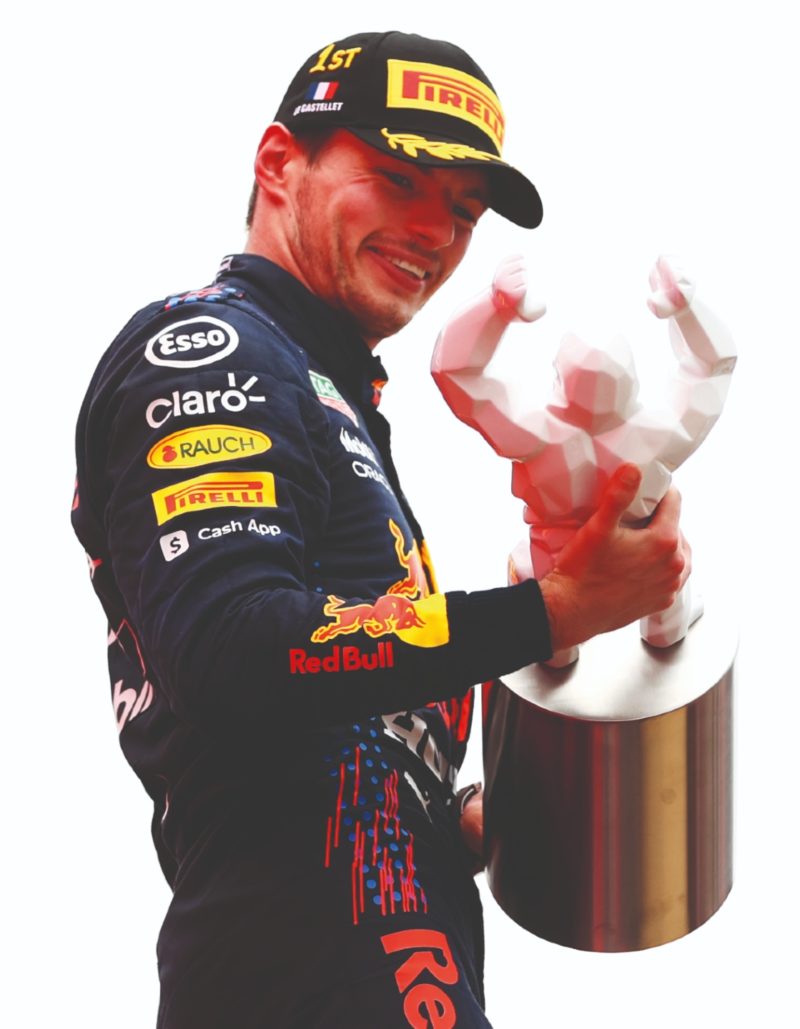
Superb drive, dodgy trophy: Verstappen cradles the spoils of the French GP
Getty Images
Ricard was the first time this season where the Red Bull was decisively faster down the straights than the Mercedes. How much of this was the new power units and how much the further development of Red Bull’s aero (it arrived here with a new variation on its spoon rear wing) was ultimately unknown. Mercedes calculated it was losing 0.25sec to the RB16B on the straights. Verstappen beat Hamilton to pole by 0.258sec. Flexi wings were all-but-forgotten at this race where the new measuring protocol came in.
“We’ve looked at it very carefully in simulation,” answered Toto Wolff to the question of why they were running with visibly more rear wing than the Red Bull. “For us, we would lose more time in the corners than we’d gain on the straights. This is the optimum for us.” Which means either the Red Bull, with a greater proportion of its total downforce being derived from the underfloor, is simply more efficient and can therefore do its optimum time with a smaller rear wing. Or the Honda has more power. GPS evidence lay the explanation more in favour of the former.
But Honda’s part in why the aero of the Red Bull might be more efficient shouldn’t be overlooked. It’s smaller even than the original ‘size zero’ of 2015. Re-assessed priorities regarding the efficiency of energy recovery versus combustion efficiency led to a significant increase in valve angle, allowing the head to be much lower. Honda has given Red Bull more room for downforce creation and lowered the centre of gravity.
All that could have been wasted in the opening seconds at Ricard as Verstappen got a big oversteer slide into the first corner which forced him briefly onto the run-off area – and allowed Hamilton to take the lead. Hamilton and Mercedes appeared to be poised to take full advantage of the Verstappen error and on their way to victory but the latter had a surprise in store for them around the pit stops.
It happened like this: Valtteri Bottas had locked a wheel in his chase of Verstappen and by the 17th lap the vibrations from the flat-spot were becoming severe. Mercedes brought him in, obliging Red Bull to respond with Verstappen to prevent losing a place to the undercut of Bottas’ new tyres. Bottas gained.
Alpine’s sporting director Alan Permane commented: “We don’t have the tricky gizmos that other teams have clearly got. There’s a wonderful line about it in the technical regulations that says any sensors must only be used passively. It’s difficult to understand how other teams are – some teams have even got guns doing such quick times with automated guns which reverse direction automatically. Difficult to understand how they do that without having sensors and control systems, which effectively are not allowed.
“If teams really are using sensors to automatically release their cars, therefore taking the human reaction time out, it will help us.”
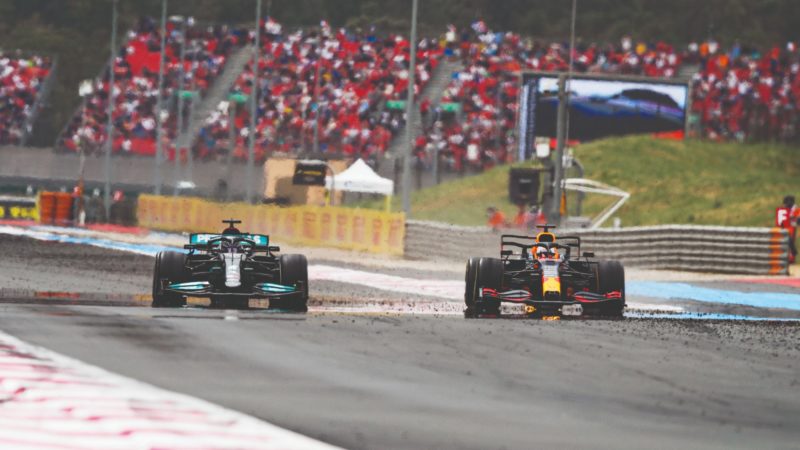
Across three straight fights, Verstappen bested Hamilton in each of them. It was tightest in France, with the Red Bull winning by less than 3sec
DPPI
1.1sec in that process. Before Verstappen stopped, Hamilton had been leading him by 3.1sec. Easily enough, reckoned Mercedes, to leave Hamilton out two laps longer than Bottas (i.e. a lap longer than Verstappen). It wasn’t.
Verstappen, having backed away from Hamilton to save his tyres, had plenty of life left in them as he let rip with an in-lap 0.9sec faster than Hamilton would subsequently do. Even more damaging was Verstappen’s great out-lap – which was 1.8sec faster than Hamilton’s in-lap. Combined with a shorter pitstop loss for Red Bull, it added up to that 3.1sec – and Hamilton came out not 1.5sec ahead, as Merc had advised him, but level, going slower and on the outside for Turn 1. Verstappen was through. Hamilton hadn’t been aggressive enough on the in-lap, uncertain that it was the in-lap until partway through it. His approach up to the box – which was the first in the pitlane – was relatively gentle, and he lost a lot of time to wheelspin as he left. This was not Mercedes at its sharpest and they were punished by the relentlessly on-it Verstappen.
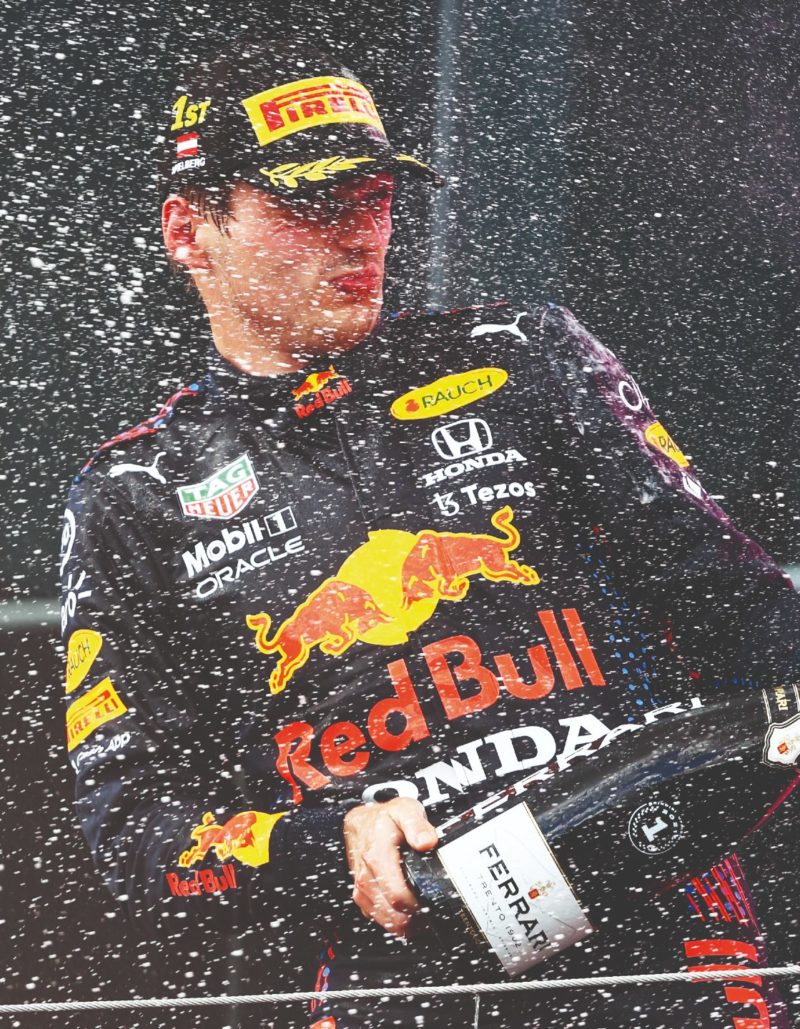
Verstappen: bringing fizz to the season
Getty Images
Sergio Pérez’s Red Bull was always in the way of allowing Mercedes to bring Hamilton in for a second stop to attack Verstappen that way. With front tyres that were graining for everyone, if Hamilton had stopped again he’d have needed to overtake Pérez just to get to Verstappen – and with a straight-line speed shortfall. But just in case, Red Bull brought Verstappen in for a second stop. He dealt comfortably with Bottas after rejoining, caught the tyre-troubled Hamilton on the penultimate lap and with way more tyre grip simply slung it down the inside into the Mistral chicane and out-braked the Mercedes for the victory. Bottas fell prey to a late fresh-tyred assault from Pérez, who took third by going around the outside of Signes.
Styrian Grand Prix
The Red Bull Ring was hosting two consecutive races, just like last year, the extra event to replace the lost Canadian/Turkish race. So it was the replacement for the replacement in these Covid-randomised times.
The Styrian Grand Prix preceded the Austrian. Red Bull showed up with an interesting new diffuser on Verstappen’s car (see F1 tech). It underlined once again just how aggressively Red Bull was pursuing this championship chance after seven years of Mercedes domination. The Mercedes was just as it had been for the previous few races.
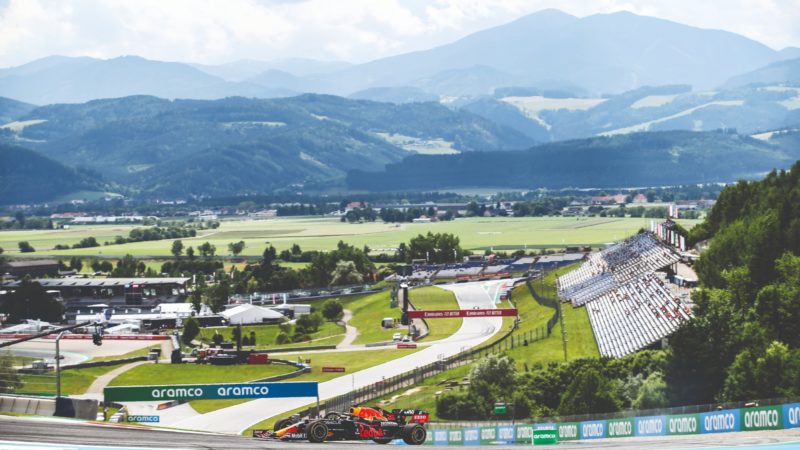
Home turf for Red Bull turned out to be perfectly picturesque, with Verstappen winning twice to open out a healthy points lead
DPPI
Again the RB16B was gaining 0.25sec on the straights over the W12, but the lap time advantage was even greater. Unlike in France there wasn’t really a contest. Verstappen converted his pace advantage into a dominant win. But how a dominant car’s race plays out in the modern era of heat-degrading tyres, regular safety cars and strategy battles, is quite different to times past. There is no point in pulling ever-further away from the pursuer, then being a sitting duck on worn tyres after a safety car wipes out your hard-won advantage. Instead, you first of all pull out of the 1sec DRS range before that feature is enabled on the third lap (tick), then you ensure that by the time the pitstop window opens (from around lap 15 onwards) you are far enough clear to have the undercut covered (around 4sec to be safe… tick) so you can pit a lap later than your pursuer without losing position to them. Then you bring your new tyres in nice and gently to ensure they aren’t slow at the end, stay out of DRS range and monitor the tyre temperatures, usually of the left-rear around this place (tick, tick and tick). Even doing it like this, without any stress at all, and with the engine turned down, Verstappen was 17sec clear of Hamilton when the latter pitted two from the end for new tyres, just so he could take the point for fastest lap and at least limit the damage.
“It’s no secret, Red Bull has the faster car at the moment”
“We were flat-out,” said Hamilton. “Then you have to apply some tyre management and then you’re even further off. I think Max was able to manage his pace and still be pulling away.” In times past, such superiority might have put Verstappen halfa-lap clear at the flag were they both able to go flat-out the whole way. It looked every bit as dominant as a typical Mercedes performance from any point between 2014-20.
“It’s not a secret, there is a trend,” said Merc boss Toto Wolff afterwards. “They have the faster package at the moment. We need to utilise our tools and our intelligence to understand our car, set-up work, the tyres and what it needs to deploy and then we need to be faultless. I believe if we can align those stars we can win the championship.”
He sounded like he was trying to convince himself as well as the watching world. Bottas this time was able to fend off the fresh-tyred Pérez at the end to take third. They’d each been in a support role to their title-contesting team-mates but had been delayed in lending that support by spending the first 10 laps stuck behind the overdelivering McLaren of Lando Norris, who had outqualified Pérez and started ahead of Bottas on account of a three-place grid drop for the latter.
Austrian Grand Prix
Several truck loads of parts had arrived from Milton Keynes both during the Styrian Grand Prix weekend and in the gap between that race and this one. The Red Bull production department had been flat-out making the parts churned out by the wind tunnel programme. There wasn’t time to make more than one of each component. So Verstappen’s car, in addition to the new diffuser from Styria, this time began with a new front wing and barge boards. Pérez got upgraded to the latest diffuser but stayed with the old wing and barge boards.
Mercedes… there were no truckloads of parts arriving from Brackley. Instead, Hamilton had spent several days on the simulator, checking out a new set up direction, trying just to squeeze the existing lemon. Hamilton hates simulator work, had used it by his own admission maybe three times in the previous three seasons. But needs must. Mercedes was trying to find a different – more Red Bulllike – way of delivering the lap time. With a set-up based around the smaller, single-pylon rear wing. It showed promise in simulation; it was found wanting in the real world of Friday practice. Hamilton reverted to something approximating to the standard set up for the rest of the weekend. “Every time we try to squeeze more from it, it gets worse,” he observed on Friday afternoon.
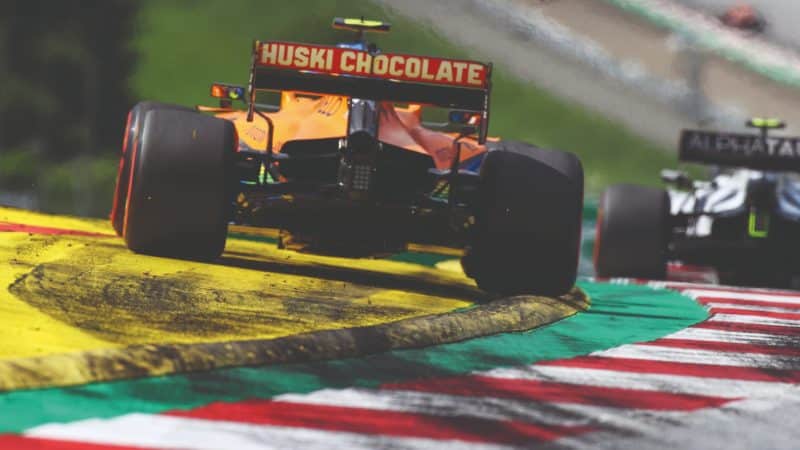
Lando Norris, aka the Master of Spielberg, celebrated yet another podium place in Austria
Getty Images
A tyre selection one step softer than in the previous weekend’s race only seemed to hurt Mercedes more. It just didn’t like the C5 soft tyre, the understeer couldn’t be balanced out. It wasn’t a race tyre but it had enough of a single lap grip advantage over the C4 medium that it needed to be used in Q3.
“Low-rake cars like the Mercedes have nothing left to give”
Which was enough not only for Red Bull to increase its advantage, despite Verstappen not having got his tyres fully warmed at the beginning of his final lap, but it allowed Norris’ (upgraded) McLaren to sneak ahead of them too! In fact, Norris missed out on stealing pole from the compromised Verstappen by only half-a-tenth. It was a stunning demonstration of his talent and confirmation of the strides made by McLaren. But it also reflected how the McLaren’s rear wing is configured to give a very big DRS boost, even at the expense of efficiency in non-DRS running. In qualifying DRS can be run in all the zones and this track, with its three zones, features the biggest proportion of DRS running over the lap on the calendar. Hence it’s perfectly configured for McLaren. But the lap still had to be driven and Norris did so to spectacular effect.
The McLaren wasn’t really a faster car than the Mercedes. But on the C5 tyres and with a Mercedes handling imbalance it was. When a car is working as well as the McLaren around here – it was generating tyre temperature quickly and pointing its nose into the apex with the bare minimum of steering lock –a driver can find laptime from within in a way that isn’t possible when the car won’t co-operate.
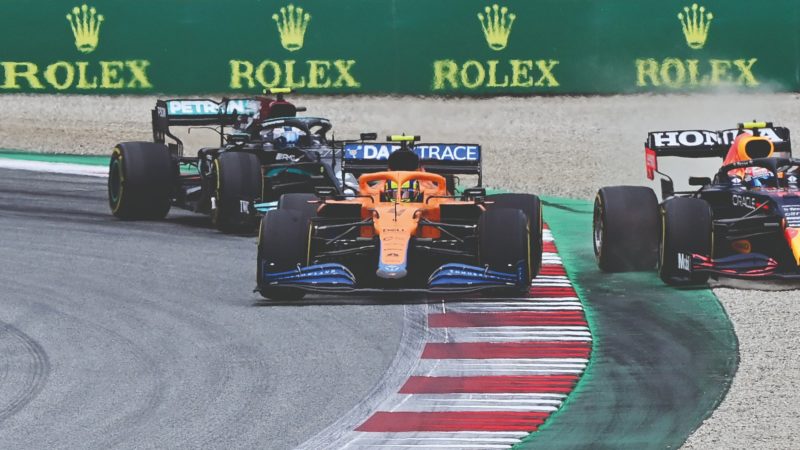
Was this really worth a penalty? Pérez skates off after trying to run around the outside of Norris in the Austrian Grand Prix
Getty Images
Hence Norris would only exaggerate Verstappen’s dominance of this race, by bottling up the Mercs behind him for 19 laps before its rear tyres finally gave out and allowed Hamilton to pass. But Bottas was only able to get by after Norris served a 5sec penalty in the pits for contact with Pérez when the latter was trying to pass.
Hamilton was later slowed by a broken ‘cake tin’ (the shroud around the brake disc which directs the air to the appropriate places) at the left-rear which forced him into a second stop, limiting him to a fourth place finish and putting Norris on the podium. Verstappen had the luxury of a free pitstop for new tyres on which he set the race’s fastest lap. It was, he said, the most perfect race he could recall.
